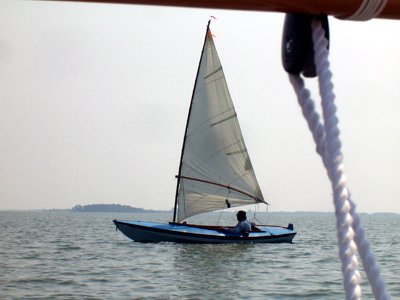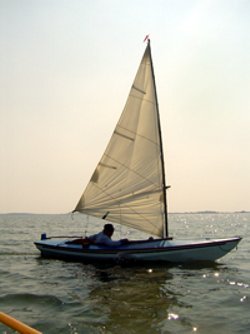Bluestocking
|
||
|---|---|---|
A decade ago, I was sailing a beautiful but very small sailing canoe, a MacGregor Canoe designed by Ian Oughtred. She was a great boat for daysailing and short trips, but my sailing buddies, John Guidera and Phil Maynard had slightly larger boats and had the urge to go a little further. We had discovered the wonders of the Assateague Island Federal Seashore where we could sail and camp in fairly protected waters of Sinepuxent Bay. They would support me by carrying some of my camping gear and extra water, and they would keep a close eye to see that I didn't get into any trouble. That was okay for the first sailing season, but come winter I started looking for a bigger boat. Sure enough, an advert came up in WoodenBoat for a Bolger Gypsy, and in snowy February trip, my wife and I drove down to Annapolis; she was just the right boat of Assateague and Chincoteague. We strapped her ontop of my car and brought her home. I named her BLUESTOCKING because Jean is a professor of Psychology, and that name seemed to fit. I sailed her hard and discovered that, being designed as a rowboat, she didn't have much freeboard. In wind and seas, she had a tendency to swamp. The water often came over the side and kept me bailing if I wanted to get home again. I decided that I could make a sunbrella deck and washboard arrangement that would keep the water out, but the canvas deck didn't really keep the water out. So I set up BLUESTOCKING in my garage over the winter and built a high camber 3 mm occume deck with cockpit coamings around an arrowhead shaped cockpit. What a difference ! She suddenly became a premier oar/sail expedition boat. Her five plank hull meant that she had narrow waterline beam but great stability as the hull listed under sail. Over the years, I changed almost everything, wishbone boom, windsurfer and carbon fiber spar, rudder, daggerboard, interior. She grew too heavy for cartopping, but I found that a trailer was easier to handle. I wrote to Phil Bolger about my alterations, and he gave at least tacit approval. Nobody said the life of a small boat designer is easy. She just kept getting better and better. One day I was camping at the remote Assateague campsite, Green Run, and a canoeist told me he had seen me sailing way up in the shallows of the barrier island. He said "You were sailing where it's so shallow that I can't paddle a canoe." Another trip it blew hard from the North, but I had to make it home. I struck the rig to row home, but my bronze oarlock broke; I was committed to Then I discovered racing. We have a PHRF handicap series at a local lake, Bluestocking and I took to dinghy racing. It was a blast. We didn't go to windward as well as the competition, but downwind we passed everybody. She maneuvered so fast we could round the leeward mark with just inches to spare, squeezing into spots that the bigger boats couldn't close on us. One racing season, I didn't miss too many races and garnered a second for the year. The real trouble is that no boat is really perfect. We have to keep trying to build newer and better, faster and faster. I looked in my backyard and realized that something had to go. My sailing canoe had long gone to a new home, and now it was Bluestocking's turn. She found a new family with children and a home on Barnegat Bay, and I am into a new chapter. |
||


 sailing with a couple of reefs. First thing I learned was that I should raise my daggerboard so that, in a gust, instead of capsizing, she just skated off to leeward. Then, when short of the launchramp, I found that the North wind had emptied Sinepuxent Bay so that it was so shallow that I had to drag her home by the painter. That's what I did, and I was home on time.
sailing with a couple of reefs. First thing I learned was that I should raise my daggerboard so that, in a gust, instead of capsizing, she just skated off to leeward. Then, when short of the launchramp, I found that the North wind had emptied Sinepuxent Bay so that it was so shallow that I had to drag her home by the painter. That's what I did, and I was home on time.